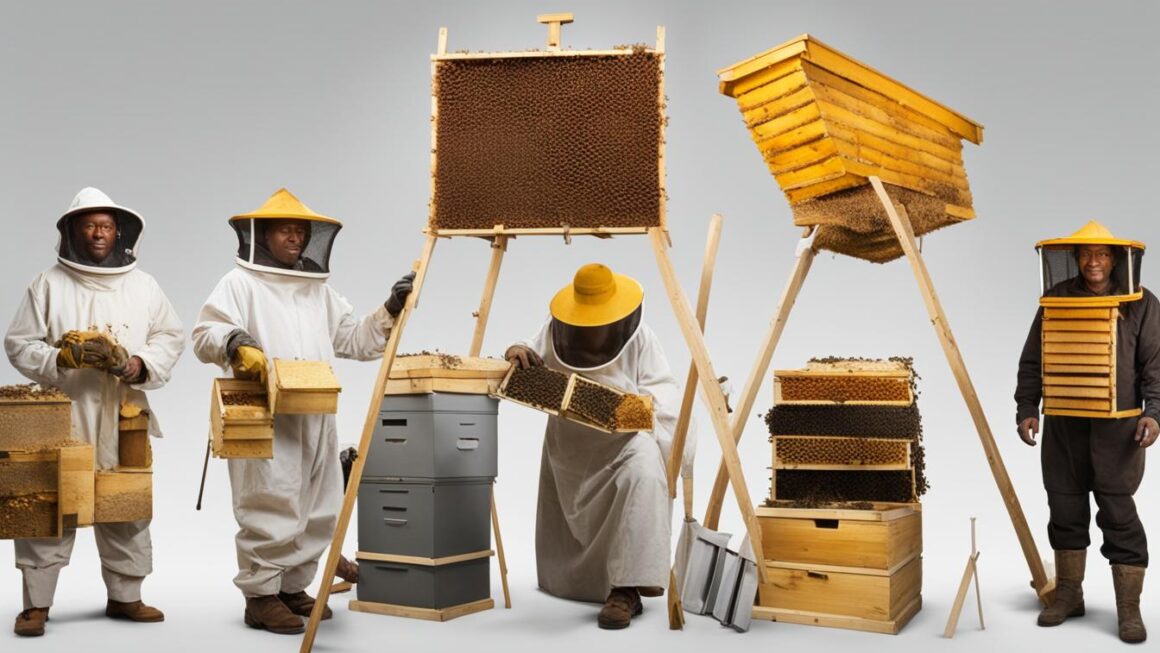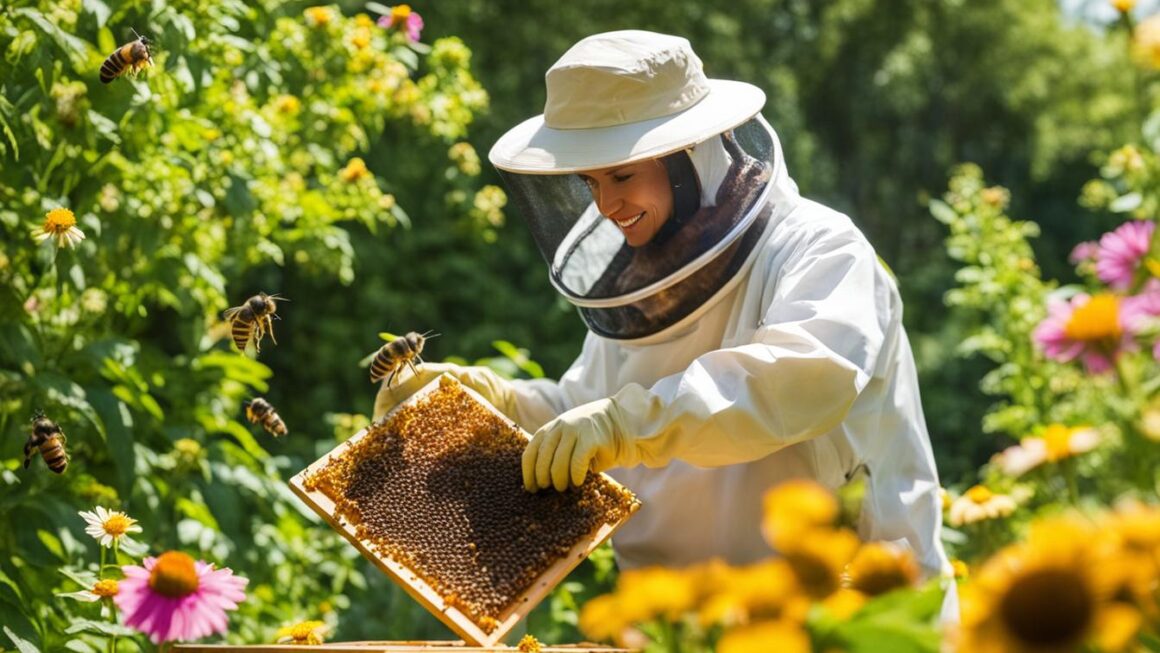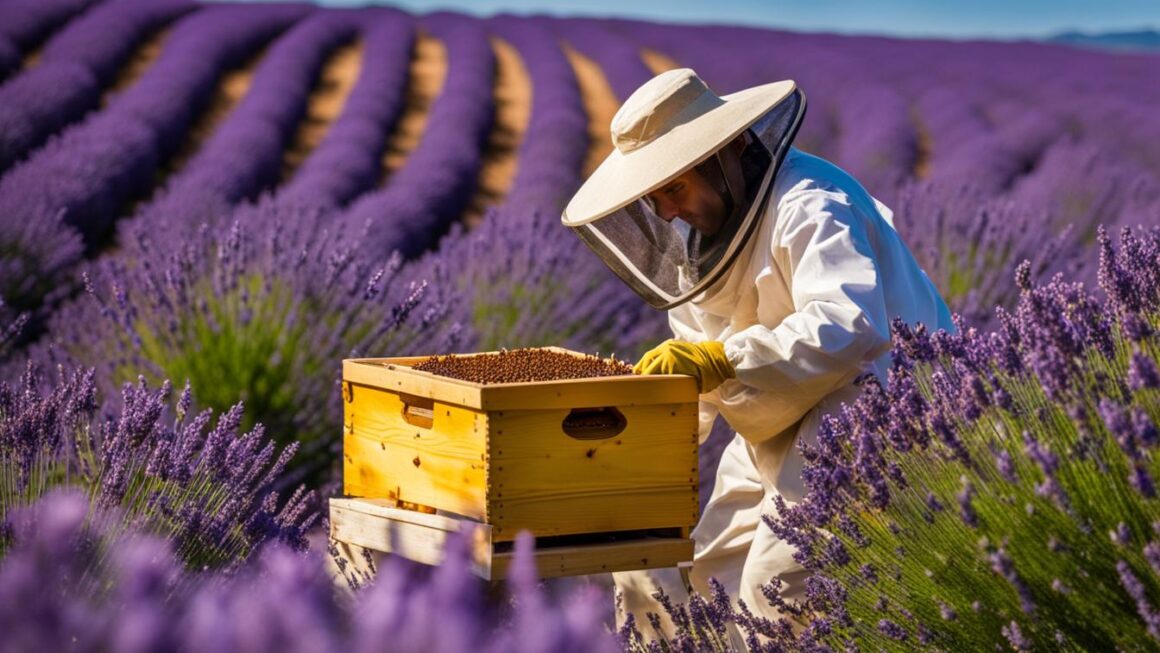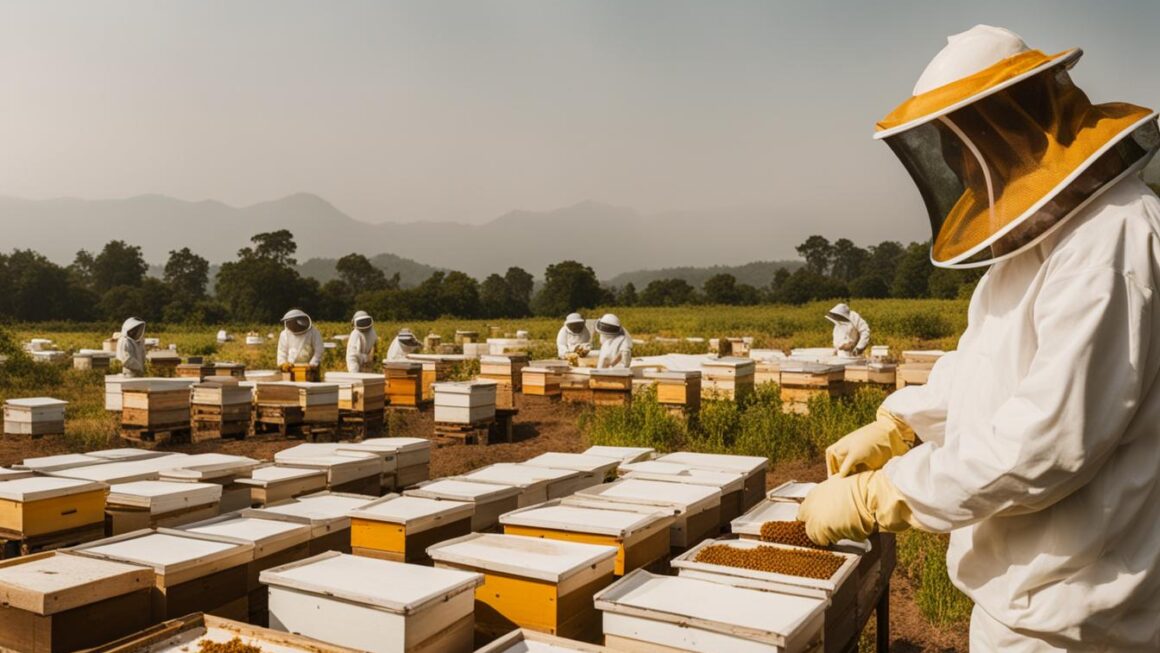Take a moment to look back at the fascinating history and transformation of beekeeping. From ancient times to modern innovations, beekeeping has played a vital role in the development of human civilization. Let’s explore the historical facets of this timeless craft and its evolution, particularly in the United States.
Key Takeaways:
- Beekeeping has a long and rich history, dating back thousands of years.
- Ancient civilizations valued honey and beeswax for various purposes.
- Hive developments and innovations have improved beekeeping practices over time.
- Migratory beekeeping has had a significant economic impact, especially in the United States.
- Modern technology continues to revolutionize beekeeping and make it more efficient.
Early History of Beekeeping
Beekeeping has a rich history that stretches back thousands of years. The earliest evidence of honey collection dates back 15,000 years ago in Spain. However, organized beekeeping as we know it today was first recorded in ancient Egypt, around 5,000 years ago. Beekeepers in ancient Egypt were resourceful and innovative, employing various techniques to find the sweet spot for honey production.
Hive Developments:
In ancient Egypt, beekeepers developed unique hive designs to accommodate their bees. They transported their hives up and down the Nile, following warm weather and blooming flowers. This nomadic approach allowed them to maximize honey production by ensuring their bees had access to abundant nectar sources.
Using Bees for Pollination:
In addition to honey production, ancient Egyptian beekeepers recognized the value of bees for pollination. They understood the crucial role bees played in ensuring the abundance of crops through cross-pollination. This early understanding of the importance of bees for pollination laid the foundation for modern agricultural practices.
Beeswax:
Another valuable resource in beekeeping is beeswax. In ancient Egypt, beeswax had various uses, including making candles, embalming, and as a sealing material. The production of beeswax was closely connected to honey production, as it was extracted from the hives alongside honey.
Early History of Beekeeping
| Key Points | Details |
|---|---|
| Finding the Sweet Spot | Ancient beekeepers transported their hives to follow warm weather and blooming flowers, maximizing honey production. |
| Hive Developments | Ancient Egyptians developed unique hive designs to accommodate their bees and simplify honey extraction. |
| Using Bees for Pollination | Ancient Egyptians recognized the value of bees for pollination, understanding their role in ensuring crop abundance. |
| Beeswax | Beeswax, a byproduct of honey production, had various uses in ancient Egypt, including candle-making and embalming. |
“Early beekeepers in ancient Egypt were pioneers in hive developments and understood the importance of bees for both honey production and pollination.” – Beekeeping historian
Ancient Honey, Wild Hive, and Beeswax in Early Civilizations
Ancient civilizations held honey in high regard, recognizing its value as a treasured commodity. In their pursuit of this golden nectar, they ventured into the depths of the wild, searching for hidden treasures known as wild hives. These hives were coveted secrets, carefully guarded by beekeepers who understood their significance. The beeswax produced as a byproduct of honey production was equally prized, finding a multitude of uses in various aspects of daily life.
The importance of beeswax in ancient civilizations cannot be overstated. It was utilized extensively in embalming rituals, ensuring the preservation of the deceased. Beeswax served as a sealant for coffins, protecting the resting places of the departed. Its versatility extended to the realm of writing, where it was fashioned into writing instruments, enabling the recording of history and knowledge. Additionally, beeswax played a vital role in the production of candles, providing much-needed light during ancient times.
“Beeswax, the golden gift of nature, has left a lasting mark on the history and development of early civilizations.”
Ancient Honey and Beeswax: A Symbol of Wealth and Trade
Ancient honey and beeswax were not only functional but also held significant economic value. In some cultures, honey was seen as a symbol of wealth and prosperity. Its abundance was often associated with fertile lands and bountiful harvests. Beeswax, on the other hand, found itself in the realm of trade, becoming a form of currency in certain regions. Its value extended far beyond its practical applications, reinforcing its status as a precious and sought-after commodity.
Table: Uses of Beeswax in Ancient Civilizations
| Application | Examples |
|---|---|
| Embalming | Mummification in ancient Egypt |
| Sealing | Coffin seals in ancient Greece |
| Writing | Creation of wax tablets for recording information |
| Candle-making | Lighting the way in ancient Roman households |
Ancient honey, wild hives, and beeswax contributed to the rich tapestry of early civilizations. Their significance went beyond mere sustenance, encompassing economic trade, cultural symbolism, and utilitarian applications. As we delve deeper into the historical perspectives and evolution of beekeeping, let us continue to appreciate the profound impact these natural treasures have had on human civilization.

Ancient Uses of Beeswax:
- Embalming and coffin sealing
- Writing instruments
- Candle-making
- Symbolic and religious significance
Beeswax’s long-standing presence in human history is a testament to its enduring appeal and utility. From its use in ancient civilizations to its continued relevance in the modern world, beeswax remains a valuable substance cherished for its versatility and natural properties.
Modern Innovations in Beekeeping
Modern technology has revolutionized beekeeping, offering innovative solutions to enhance the craft while prioritizing the well-being of bees. Two notable innovations in the industry are the Flow Hive and the Powerblanket Bee Blanket. These advancements have made beekeeping more efficient, sustainable, and bee-friendly.
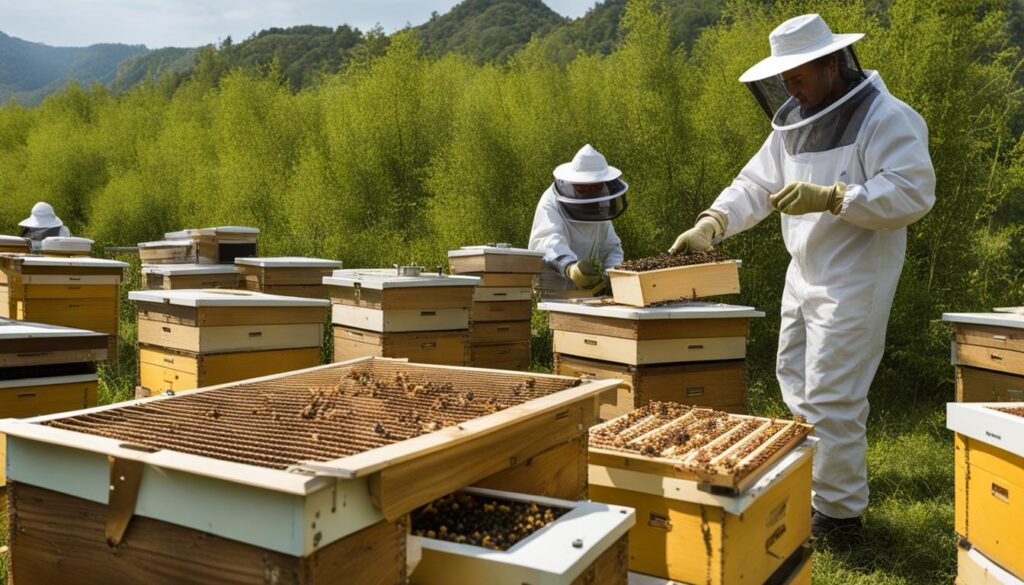
The Flow Hive, invented by Stu and Cedar Anderson, has transformed the way honey is extracted from beehives. This innovative design allows beekeepers to harvest honey without disturbing the bees, minimizing stress and preserving the hive’s delicate ecosystem. The Flow Hive utilizes specially designed frames that enable honeycombs to be effortlessly drained, resulting in a more efficient and gentle honey extraction process.
Another significant innovation in modern beekeeping is the Powerblanket Bee Blanket. This technology provides precise temperature control for harvested honey, ensuring it remains at optimal conditions without losing its nutritional value or undergoing degradation. The Bee Blanket protects the honey from external elements while maintaining a consistent temperature, ultimately preserving its quality and taste.
Comparing the Flow Hive and the Powerblanket Bee Blanket:
| Flow Hive | Powerblanket Bee Blanket |
|---|---|
| Allows honey extraction without disturbing bees | Maintains precise temperature control for harvested honey |
| Efficient and bee-friendly honey extraction process | Preserves nutritional value and quality of honey |
| Minimizes stress on the hive ecosystem | Protects honey from external elements |
These modern innovations in beekeeping demonstrate the industry’s commitment to improving practices while prioritizing the welfare of bees. The Flow Hive and the Powerblanket Bee Blanket are just two examples of how technology continues to enhance and evolve beekeeping, ensuring a sustainable and thriving future for both bees and beekeepers.
Evolutionary Perspective on Beekeeping
Adopting an evolutionary perspective on beekeeping allows us to understand the challenges faced by both bees and beekeepers. Honey bees have a long evolutionary history, shaped by the processes of natural selection. The concept of natural selection, famously introduced by Charles R. Darwin, plays a significant role in the adaptation of honey bees to their environments. Through this process, different subspecies and ecotypes of honey bees have evolved, each possessing unique traits that make them well-suited to their specific habitats.
Charles R. Darwin’s theory of adaptation by natural selection provides a framework for understanding how honey bees have thrived and diversified over time. Bees that possess advantageous traits, such as efficient foraging strategies, resistance to pests and diseases, and the ability to communicate effectively within their colonies, have a higher chance of survival and reproduction. These traits are then passed on to future generations, leading to the continued evolution and adaptation of honey bees.
“It is not the strongest of the species that survives, nor the most intelligent that survives. It is the one that is most adaptable to change.” – Charles R. Darwin
By studying honey bee evolution, beekeepers can gain insights into the characteristics and behaviors that contribute to the success of healthy colonies. This knowledge can inform their management practices, such as providing appropriate habitats, minimizing stressors, and promoting genetic diversity within their bee populations. Understanding the adaptive nature of honey bees also highlights the importance of preserving and protecting their natural habitats, as well as promoting sustainable beekeeping practices that prioritize the well-being of both bees and their environments.
Summary:
Beekeeping from an evolutionary perspective reveals the fascinating adaptation of honey bees to their environments over time. Charles R. Darwin’s theory of natural selection emphasizes the importance of advantageous traits and their inheritance, shaping the diverse subspecies and ecotypes of honey bees we see today. By applying this knowledge, beekeepers can make informed decisions to maintain healthy colonies and promote sustainable practices, ultimately protecting the well-being of bees and their habitats.
Economic History of Migratory Beekeeping
Migratory beekeeping has had a significant economic impact, particularly in the United States. The development of pollination markets, where beekeepers provide their services to crop growers, has been closely tied to the practice of migratory beekeeping. These markets help coordinate the demand for pollination services and ensure the cross-pollination of crops, leading to increased crop yields and economic productivity.
The economic impact of migratory beekeeping is multi-faceted. First and foremost, it provides an essential service to farmers by ensuring the pollination of their crops. Many crops, including almonds, apples, and blueberries, rely heavily on honey bee pollination for optimum yields. By transporting honey bee colonies to different locations at specific times during the year, beekeepers facilitate the pollination process and contribute to crop production.
Furthermore, the development of pollination markets has created a new revenue stream for beekeepers. Beekeepers can now negotiate contracts with crop growers, providing pollination services in exchange for fees. These fees vary depending on factors such as the size of the crop, the level of demand for pollination services, and the number of honey bee colonies required. For beekeepers, migratory beekeeping and participation in pollination markets have become essential for sustaining their businesses and generating income.
The Impact of Pollination Markets on Beekeepers and Farmers
Pollination markets have not only benefited beekeepers but also provided a valuable solution for farmers. By engaging the services of migratory beekeepers, farmers can ensure that their crops receive adequate pollination, leading to higher yields and improved crop quality. This, in turn, has a positive economic impact for farmers, allowing them to produce more and higher-quality crops, thereby increasing their profitability.
The development of pollination markets has also created a system of collaboration and cooperation between beekeepers and farmers. Beekeepers carefully plan their migratory routes, taking into consideration the specific crop flowering periods and geographical locations. This collaboration ensures that honey bee colonies are available at the right time and in the right place to support pollination efforts. It also fosters a mutually beneficial relationship between beekeepers and farmers, as both parties rely on each other for their respective economic success.
| Beneficiaries of Migratory Beekeeping and Pollination Markets | Benefits |
|---|---|
| Beekeepers | Economic sustainability, revenue generation |
| Farmers | Increased crop yields, improved crop quality, profitability |
| Consumers | Access to diverse and abundant agricultural products |
| Environment | Promotion of biodiversity, preservation of natural habitats |
Migratory beekeeping and the development of pollination markets have not only had a direct economic impact but also contributed to the overall sustainability and biodiversity within the agricultural landscape. The coordinated movement of honey bee colonies has the potential to support the pollination of a wide range of crops, ensuring the availability of diverse and abundant agricultural products for consumers. Additionally, by promoting the presence of honey bees in different regions, migratory beekeeping contributes to the preservation of natural habitats and the conservation of pollinator populations.
Modern-Day Migratory Beekeeping
Migratory beekeeping in the 21st century involves the seasonal movement of honey bee colonies by truck. Beekeepers follow specific pollination routes, starting with the almond groves in California and then moving to different crops across the country. This practice is crucial for spring pollination, ensuring the cross-pollination of crops and maximizing yields for farmers.
The seasonal movements of beekeepers are driven by the need to meet the pollination demands of various crops throughout the year. In the early spring, beekeepers transport their colonies to almond orchards as almond trees heavily rely on honey bees for pollination. After the almond season, beekeepers then move their colonies to other crops such as apples, blueberries, and cherries.
The pollination routes followed by migratory beekeepers are carefully planned to optimize honey bee colonies’ health and productivity. These routes take into account the flowering periods of different crops and the nutritional needs of honey bees. By strategically moving their colonies, beekeepers can ensure that the bees have access to a diverse range of nectar and pollen sources, supporting their overall well-being.
| Season | Pollination Route | Main Crops |
|---|---|---|
| Spring | California – Pacific Northwest | Almonds, Apples, Cherries |
| Summer | Pacific Northwest – Midwest | Blueberries, Cranberries, Melons |
| Fall | Midwest – South | Pumpkins, Sunflowers, Soybeans |
| Winter | South – California | Oranges, Avocados, Almonds |
“The seasonal movements of honey bee colonies in migratory beekeeping play a vital role in supporting crop pollination and ensuring the continued success of our agricultural systems.” – Beekeeping expert
The seasonal movements of beekeepers have become an integral part of modern agriculture, as honey bees are essential pollinators for many economically important crops. Their services contribute to improved yields and the production of high-quality fruits, vegetables, and nuts. Spring pollination, in particular, sets the stage for a successful growing season, allowing crops to develop and mature, ultimately providing us with the fresh and nutritious food we enjoy.
Seasonal Movements and Honey Bee Health
The seasonal movements of honey bee colonies not only support crop pollination but also play a role in maintaining honey bee health. Moving colonies to different environments reduces the risk of nutritional deficiencies and allows honey bees to access diverse sources of nectar and pollen. It also helps prevent the build-up of pests and diseases that can negatively impact colony health.
However, the practice of migratory beekeeping also presents challenges. Honey bee colonies may encounter new environmental conditions and exposure to different pesticides during their journeys. Beekeepers must carefully manage these factors to minimize stress on the colonies and ensure their well-being.
By understanding the dynamics of modern-day migratory beekeeping and its impact on honey bees and crop pollination, we can work towards sustainable practices that support both agriculture and the health of honey bee populations.
Environmental and Ecological Effects of Migratory Beekeeping
Migratory beekeeping and the introduction of the European honey bee have had both positive and negative effects on the environment and native pollinators. While honey bees are efficient pollinators and play a crucial role in agriculture, their presence can have consequences for native pollinator populations. The increased competition for resources, such as nectar and pollen, may pose challenges for native bee species. However, native pollinators have shown a remarkable ability to adapt to modified environments, which is encouraging for their long-term survival.
Studies have indicated that certain native bee populations may decline in the presence of honey bees. However, this is not a universal trend, and the effects can vary depending on the specific ecosystem and bee species involved. It is important to note that honey bees and native bees can coexist and even benefit from each other’s presence in certain situations. The key lies in maintaining a balance and preserving the diversity of pollinators.
Efforts are being made to mitigate the potential negative effects of migratory beekeeping on native pollinators. Conservation programs and initiatives are being implemented to protect and restore native bee habitats. These include creating wildflower meadows, planting native flowering plants, and providing nesting sites for solitary bee species. Additionally, educating beekeepers and the general public about the importance of native pollinators and the need for their conservation is crucial for ensuring their long-term survival.
| Effects on Native Pollinators | Adaptation to Modified Environments |
|---|---|
| Increased competition for resources | Native pollinators have shown adaptability to modified environments |
| Potential decline in certain native bee populations | Efforts are being made to preserve and restore native bee habitats |
| Potential disruption of pollination networks | Conservation programs aim to protect and promote native pollinators |
| Varied effects depending on ecosystem and bee species | Education is crucial for raising awareness about native pollinator conservation |
Conclusion
Reflecting on the rich history and evolution of beekeeping takes us on a nostalgic journey through time. A look back at the early honey collection in ancient civilizations to the modern innovations in hive designs and honey extraction techniques showcases the remarkable transformation of this timeless craft. Beekeeping has not only played a crucial role in human civilization but has also significantly impacted agricultural practices.
As we delve into the historical perspectives of beekeeping, we gain a deeper appreciation for the achievements and challenges faced by beekeepers throughout the years. The passion and dedication of these beekeepers have shaped the industry, leading to advancements that have enhanced honey production, pollination services, and the utilization of beeswax.
By reflecting on beekeeping history, we not only acknowledge the accomplishments but also learn from the past to guide us on the future path of beekeeping. With this understanding, we can continue to support and protect honey bee populations, promote sustainable practices, and ensure the preservation of this vital craft for generations to come. Beekeeping truly is a remarkable journey that connects us to our roots and allows us to appreciate the invaluable contributions of bees to our ecosystem.
FAQ
What is the earliest evidence of honey collection?
The earliest evidence of honey collection comes from Spain 15,000 years ago.
When was organized beekeeping first recorded?
Organized beekeeping was first recorded in ancient Egypt around 10,000 years later.
How did ancient Egyptians transport their hives?
Ancient Egyptians transported their hives up and down the Nile to follow warm weather and blooming flowers.
What was beeswax used for in ancient civilizations?
Beeswax was used for embalming, sealing coffins, writing instruments, candles, and as a trading currency.
Who designed a hive that prevented the killing of bees?
Englishman Thomas Wildman designed a hive that prevented the killing of bees.
What innovation did Lorenzo Lorraine Langstroth make in hive design?
Lorenzo Lorraine Langstroth discovered the concept of “bee space” and incorporated wooden boxes into hive design.
How did migratory beekeeping become popular?
Migratory beekeeping became popular in the mid-1700s when beekeepers recognized the value of bees as pollinators.
What is the economic impact of migratory beekeeping?
Migratory beekeeping has had a significant economic impact, particularly in the United States, with the development of pollination markets.
What modern innovations have revolutionized beekeeping?
The Flow Hive allows for more efficient honey extraction, and the Powerblanket Bee Blanket keeps harvested honey at the proper temperature.
How do bees adapt in modified environments?
Bees adapt to modified environments through natural selection and genetic changes.
What effects does migratory beekeeping have on native pollinators?
Migratory beekeeping may increase competition for resources among native pollinators and affect the ecology of honey bees.
How does understanding beekeeping history guide the future?
Reflecting on beekeeping history allows us to appreciate achievements and challenges and serves as a guide for the future of beekeeping.

